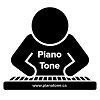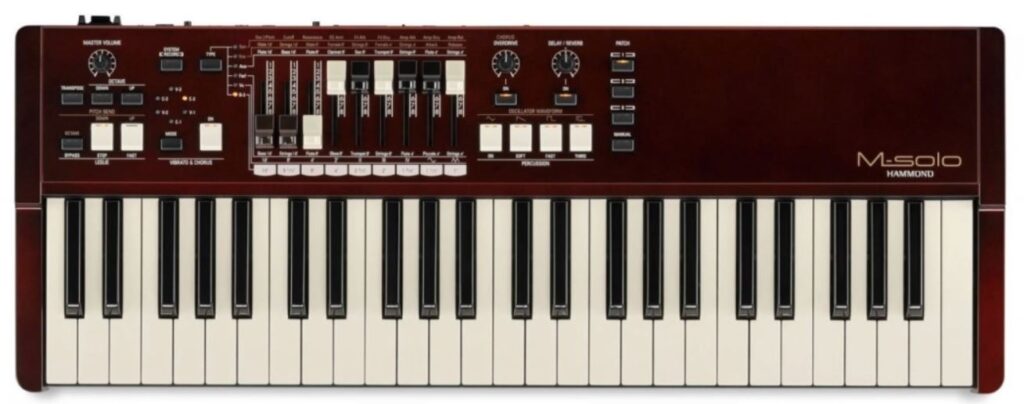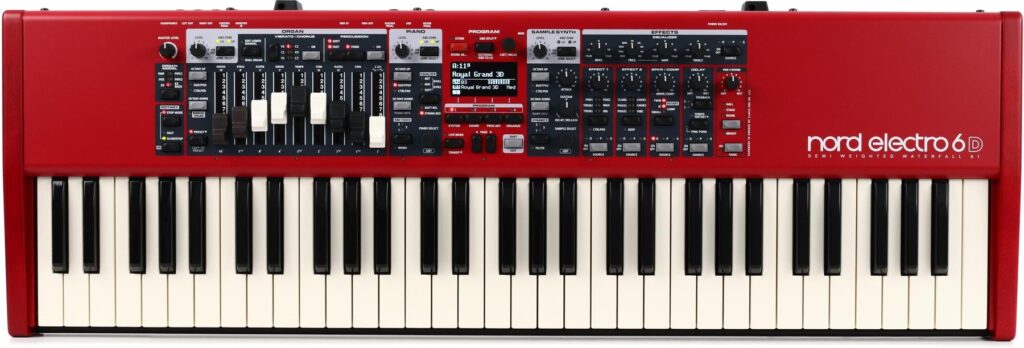Hi there! This is my review on the brand new (and SUPER cool) Hammond M-Solo organ. I bought this organ in early 2024 to be a central piece of my new keyboard rig with my band (which also includes a Studiologic Numa Compact 2X for all my non organ needs), and while I’ve only had it for a couple months, I’ve been SUPER impressed so far. And just in case you’re new to Hammond organs and how they work, here is a link to a video where Marine Lacoste, who is a pro Hammond organ player and the founder of Online Rock Lessons.com, is my guest and explains how Hammond organs work, what the drawbars do etc; so if you’re not already familiar with all of that I’d highly recommend watching that video first and then coming back to this review. So? Let’s check out the Hammond M-Solo!
What’s The M-Solo’s Intended Use?
So, you might be looking at this tiny Hammond M-Solo, which only has 49 keys, only has FOUR organ voices, a string and a synth section, has no display, just a purely button driven user interface and you might be wondering – what exactly is this for, and . . . is it worth $1300USD??? Well, to be honest? Depending on your needs and interests? The M-Solo could be anything from not even worth considering to EXACTLY what you need and worth every penny.
So what is the need that the M-Solo is intended to fill? If you’re a keyboard player who already has a fully or semi-weighted digital piano or keyboard that you use for piano, electric piano, and other sounds, but the organ sounds, functionality and key action . . . (for organ) on your main keyboard are . . . just OK, and you would really like to have a better sounding organ with proper organ functionality like drawbars, chorus, vibrato, overdrive, percussion, a key action that is more suited to playing organ; AND a REALLY good sounding Leslie rotary speaker simulation? That’s where the M-Solo comes in.
The M-Solo is meant to be a high quality but super portable Hammond organ that given it’s small size and weight of only about 8 lbs that can easily be added to a keyboard player’s existing rig to significantly improve their organ sounds.
So . . . why not just get a full size Hammond like the Hammond XK-4?:
The XK-4 is the newest full size offering from Hammond with the latest and greatest sound engine (“Modeled Tonewheel II”) and Leslie speaker simulation. And there is also the SK Pro which has the prior sound engine (“Modeled Tonewheel I”) but it also has other sounds (piano, electric piano, synth etc):

Well, I would love to have an XK-4 or an SK Pro, and . . . truth be told, I DO SEE one of those in my future, but . . . the first issue is price – Hammond organs are definitely on the expensive side; the XK-4 retails for about the same price as a Nord Electro 6D at around $2500USD.
Well, guess what? The Hammond M-Solo uses the SAME sound engine as the Hammond XK-4, but it sells for only about HALF the price!
And, it still meets all your main organ needs with proper drawbars, chorus, vibrato, overdrive, percussion and an awesome Leslie. Now . . . depending how significant your organ needs are, you might still be better off with a full-size 61 key version like the XK-4 or SK-Pro, but a lot of players, especially people that are playing piano, electric piano AND organ in a band can get by quite nicely with only 49 keys for organ comping parts and organ solos, and having that available in a second keyboard allows you to quickly and easily bounce back and forth between organ and piano parts in a song, as opposed to trying to do that on a single keyboard with splits or changing patches, etc.
So, that’s what the M-Solo is meant for, now let’s dive into the review; I’ll go over the organ controls, user interface and organ sounds first, then I’ll talk about the key action, and then the connectivity. As I mentioned earlier, the M-Solo also has dedicated string and synthesizer sections – these are definitely out of my area of expertise (and interest to be honest) but I will go over those quickly as well. So with all that out of the way? Let’s check out the Hammond M-Solo!
User Interface
I’ll go over the user interface first, it’s pretty simple because there is no menu screen or menu system, and I’m SUPER thankful that there are ZERO “function key combinations” where you have to hold a button and press some random note on the keybed to change a setting.
EVERY single setting on the Hammond M-Solo has a physical control right in front of you for easy real time control!

So this user interface is basically a “what you see is what you get”. In the top left we have the master volume, and below that we have handy octave & transpose buttons: if I press the up and down buttons, I can move up or down one octave. Note that these buttons will light up if you have shifted octaves. For transposing, you hold the transpose button and once again use the up or down keys while holding transpose. As I transpose, the lights in the vibrato and chorus section will light up to indicate how many steps I have transposed (while pressing the transpose button).
Below that, we have buttons for controlling the leslie speaker when we’re on an organ voice (I can speed up, slow down and stop the Leslie, or bypass it altogether). If I’m using either the string or synth sections, these buttons become pitch bend up or down, and if I hold the octave button and then pitch bend up or down, it will bend an entire octave. Then beside that we have the vibrato and chorus controls for the organ voices; you toggle them on or off with the switch, and press the MODE repeatedly to choose which vibrato or chorus effect you want.
Above that you have the “System Record” button, this is for saving a custom setup into one of the 3 registration memory patches; that is one thing I REALLY wish the M-Solo had was even a few more registration memory slots, even 10 would be worlds better than 3. Then the type button is for choosing your voice; so for organs we have Hammond B3, Vox, Farfisa & Acetone, then we have the string ensemble and then the synth section.
So the 9 drawbars are to the right, but these aren’t JUST drawbars for the Hammond; they also work as drawbars or just as different controls for all the other voices. And, what they do for EACH voice is thankfully labelled – you just follow the lines drawn right on the panel from each voice type to see what each drawbar does. Then to the right of the drawbars, we have a dial labelled chorus and overdrive; this will function as an overdrive for the organ voices, and as a chorus effect for the string ensemble and synth engines. You enable it with the on button and then dial in the level. To the right of that we have another knob labelled Delay/Reverb. This one has a notch in the centre; when the button is turned on, moving this to the left will add a delay effect and to the right will adjust reverb.
Below those we have the percussion controls used for the B-3 organ only, so ON to enable percussion, then you can choose soft, fast and third like on a real Hammond. For the synth engine only, these buttons are used to select your waveform as labelled. Then to the right of that under “Patch” we have the 3 registration memory buttons where you can access your 3 custom setups, and then choosing manual basically turns all the effects off so you can sculpt your sound from scratch.
So I quite like this user interface, everything you need is right in front of you and labelled which is awesome.
Sounds
As I mentioned previously, the M-Solo uses the latest and greatest sound engine from Hammond, which is the “Modeled Tonewheel II” engine also included in the XK-4, so this sound engine is actually more recent than the sound engine in the SK Pro and even the sound engine in the most expensive Hammond, the XK-5!
If you look on YouTube for M-Solo vs. MK-4, you’ll find some comparisons that basically show how those two boards sound exactly the same. So in the upcoming demo, I’ll spend 90% of my time on the Hammond organ sounds and effects, then I will very quickly go through the other sounds; while the synth engine does seem to have a lot of flexibility, as I mentioned earlier I know ZERO about synthesizers nor do I have much personal interest in them so I won’t be spending much time on those. So, let’s check it out!
So I also wanted to compare the current organ engine sounds from the M-Solo and XK-4 to those from an older organ engine to see just how much they’ve evolved. So I managed to get my hands on a Hammond SK-1 which came out in 2011; this is the predecessor for the SK Pro series which just came out in 2021, but you still see SK-1’s in use on stages all over the place, it really was (and still is) a very cool gigging keyboard. Like the SK Pro, it has other sounds in it like pianos and electric pianos. Here is a quick comparison.
Now to be honest, while I AM accumulating more experience with Hammond organ clones, I in no way consider myself an expert yet. But in my opinion, the older patches on the SK-1 still sound awesome and are totally usable; in a live situation with a band, I’m not sure I would be able to hear a huge difference if any at all between the SK-1’s organ sounds and the M-Solo’s. But with headphones in a studio situation; . . . the M-Solo does sound better to me – especially the Leslie, and the virtual multi contact keys really do add something noticeable to the sound. But I am super glad that I borrowed the SK-1, because it confirmed something I WAS kind of expecting which is; I absolutely LOVE this key action. I can play organ songs FAR better on the SK-1 than I do on the M-Solo, or on any other keyboard I’ve tried to play organ on. With that in mind, let’s move on to the key action.
Key Action
So I just mentioned that I absolutely LOVE the key action on the Hammond SK-1 (which I BELIEVE is a Fatar TP/8O keybed, but I could be wrong). So a proper Hammond organ keybed and key action is actually a bit unique, and is VERY different from a piano. Organ keybeds should be semi-weighted, not fully weighted, and not graded (so all keys should have the same weight). The shape of the keys is also really important; organ keybeds should be “waterfall” shaped; so they should have a smooth front edge on the white keys so they’re not supposed to have a lip over the front edge of the key like a piano does, AND the front edges should be nice and smooth, even a little bit rounded as opposed to having sharp corners.
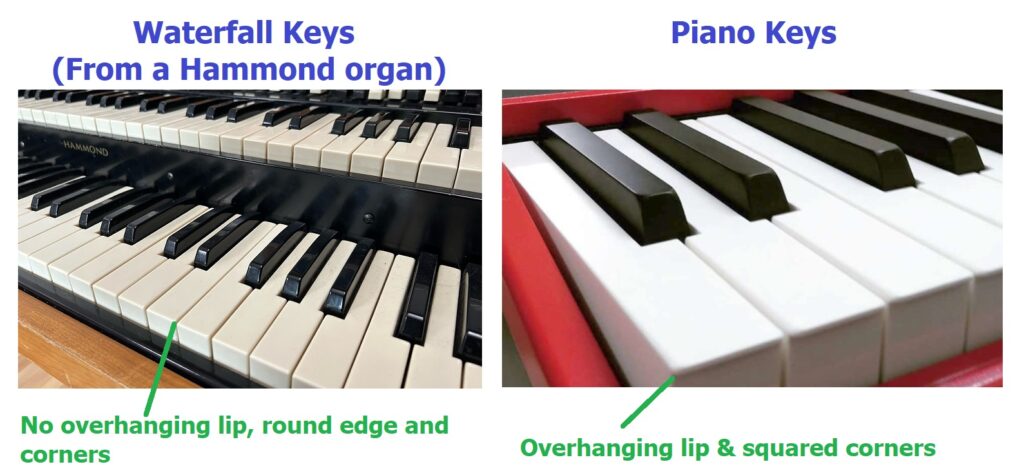
And why is this? Because doing organ slides or “palm smears” (which are the organ equivalent of a piano “glissando”) are an essential part of organ playing, and I can even tell you from my limited experience that doing these on fully weighted piano shaped keys is not easy, doesn’t work very well, and to be honest can actually hurt.
So how does the action on the M-Solo shape up? Well the first thing to note is these are NOT waterfall keys; they are synth style diving board keys, although they DO have rounded corners which DO help a great deal with those palm smears.
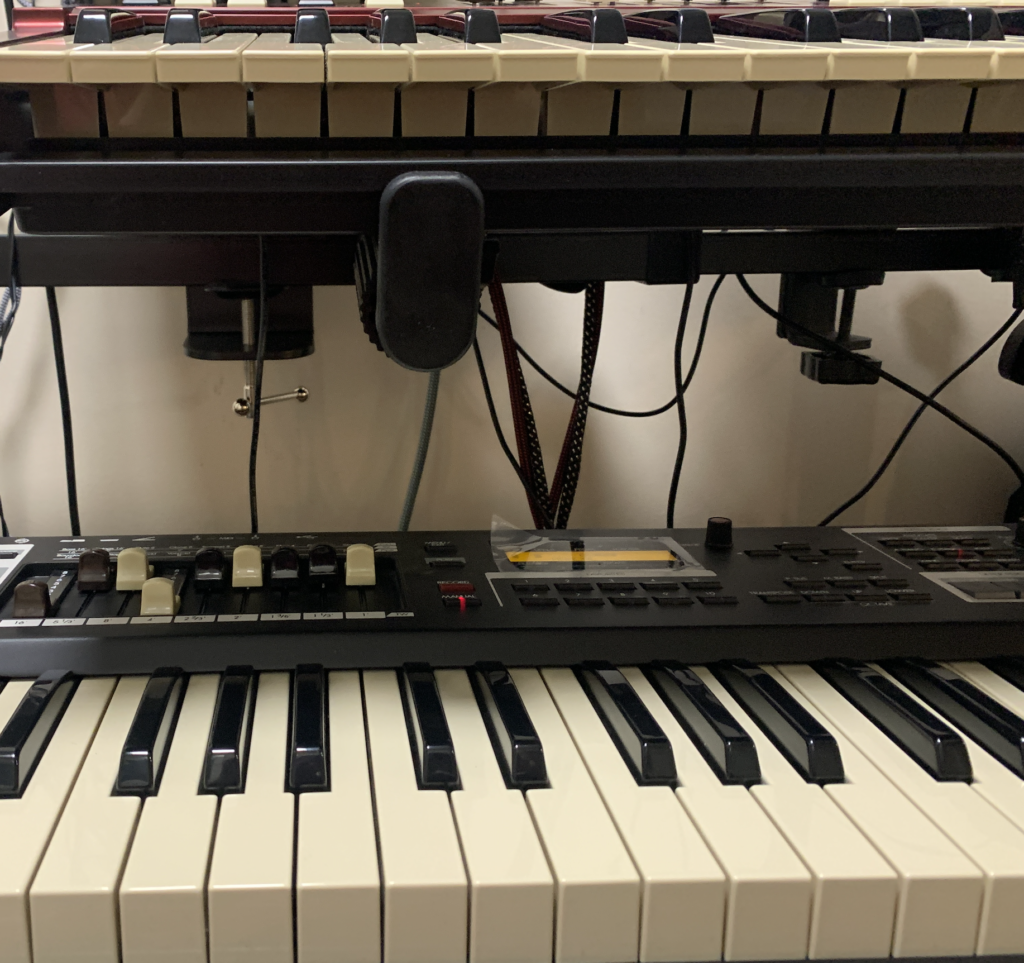
As far as the feel goes, they do feel lightly semi weighted to me. While I can’t say for sure without taking the keyboard apart, if they aren’t semi-weighted and are just spring action keys that are meant to mimick semi-weighted? Well if that’s the case, then they’re the best feeling spring action keys I’ve ever played. If I had to guess I would bet that they are slightly semi-weighted; the action actually feels VERY similar to the action on my other keyboard, my Numa Compact 2X which has a semi weighted action from a Fatar TP-9P keybed (the “P” stands for piano for the shape of the key). The M-Solo keys feel just a touch lighter than the Numa’s keys, but still feel very much the same to play, with the exception of the shape of the keys. Fatar also makes a TP-9S keybed which is a diving board synth shaped keybed version of the TP-9P, so . . . who knows.
But regardless of what keybed is in the M-Solo, how does it feel to play as far as organ actions go? I would have to say it is surprisingly playable for a non waterfall keybed. The keys are true full sized, they play nice and smooth, the weight feels good, and palm smears are totally doable. That being said however, it’s still no replacement for a proper waterfall organ keybed, so I have to say I’d happily live with a slightly bigger and heavier version of the M-Solo with a proper waterfall keybed in it. Having used it a bunch with my band, I’ve been fine playing most organ styles on it with one exception – and that’s playing a percussive style which you often see; given that it’s a slightly lighter feel, it is a bit challenging to control the left hand percussive strikes; so for those songs to be honest, I’ve started using my Numa Compact as a controller for the M-Solo. But, in comparing the M-Solo’s organ action to other non-waterfall organ centric keybeds that I’ve played that would include the Yamaha CK61 and the Roland VR-09? The M-Solo’s action is WAY better than either of those, so . . . not the end of the world, and once again you do have to keep in mind this keyboard isn’t REALLY intended to be a MAIN keyboard, it’s intended to be a high end organ add-on to your existing rig. So all that considered? The action’s pretty good.
Now before moving on to connectivity, an important feature to mention regarding the keybed on the M-Solo? It is a virtual multi-contact keybed. So . . . what does that mean? Well on a real Hammond organ which is a tonewheel organ, when you pull out drawbars, & tonewheels start to spin at slightly different speeds, so the sound you hear for each drawbar will start at a slightly different time. This behaviour and effect is replicated on the top of the line Hammond XK-5 with ACTUAL multi contacts in the keybed; on the other newer models like the SK Pro and the XK-4, and now even the M-Solo this effect is there, but it is virtual. Listen carefully as I SLOWLY press a key with just one drawbar out; you don’t notice anything right? Well what happens when I pull out TWO drawbars and do the same thing . . . now you can hear how one of them “gets up to speed” faster than the other. Pretty cool feature even if it is just virtual. So if I set the drawbars the same on the Hammond SK-1 which does NOT have that effect built in, you can hear a pretty big difference.
One thing to note here though, is that even though this is being done virtually, MIDI doesn’t seem to trigger it; when I connect my Numa Compact 2X to the MIDI in on the M-Solo to use the Numa keyboard instead, you don’t get that effect!
Connectivity
OK in the connectivity department, the M-Solo has a TON. Looking at the back panel, we have a USB to host port so you can connect the M-Solo to a device as a MIDI controller (note that this is MIDI only; there is no audio interface built into this port which is a bit unfortunate). But we do have 5 pin MIDI in and out ports, and this is a VERY important feature for this keyboard in my opinion, in particular the MIDI in port. While the keybed on the M-Solo IS great for such a light and small keyboard, as I mentioned, a proper waterfall style keybed is still FAR better for organ. So having a MIDI in port allows you to connect another keyboard with 61 or more keys and a better organ key action to trigger the awesome sounds on the M-Solo, so you basically get the best of both worlds; like this Hammond SK-1, or even my Numa Compact 2X which has a semi-weighted keybed that IS pretty decent for playing organ).
Then we have an expression pedal in, which is vital for organ playing, for managing the volume. And then there is a “Leslie Fast” port which is basically a port for a switch pedal (any basic sustain pedal will work) for an easy way to switch your leslie speed back and forth from slow to fast without having to use the panel button. And a nice touch here, is there is a polarity switch built right into the keyboard, so if your pedal doesn’t have a polarity switch you’re still good to go. Then there is a 1/8″ aux in along with a volume control for connecting a device to stream audio into the M-Solo. Then we have proper left and right outs (with the left being a summed left and right mono signal when used by itself). Then there is a 1/4″ stereo headphone port, and then the power port. So, other than not having a mic input or a built in audio interface? Pretty good set of connectivity here, definitely optimized for a gigging keyboard.
What’s Missing / Could Be Improved?
So what’s missing on the Hammond M-Solo? Some might say Bluetooth audio in, but to be honest? This is MEANT to be a gigging keyboard, and Bluetooth audio in for a gigging keyboard is something I would NEVER use if I needed to stream in audio; I would always use the 1/8″ audio in anyways. But as awesome as the M-Solo is, there are 2 things that would make this exponentially better in my opinion: the first small thing would be to add just a few more registrations banks; even getting that up to 10 would be a BIG improvement. But the big one? As decent as the key action is on the M-Solo, having SUCH a powerful organ engine without proper waterfall keys really is a shame; I would LOVE to have seen a slightly heavier and bigger M-Solo with proper keys (although maybe Hammond did that on purpose . . . how many XK-4 sales would Hammond lose out on if the M-Solo had proper keys?)
The Competition
While there is competition out there for the “main” Hammond organ models like the XK-4, SK Pro and XK-5 (for example, organs like the Crumar Mojo would be competition for the XK-4, and the Nord Electro or Yamaha YC61 are direct competitors for the SK Pro), there really ISN’T anything that competes directly with the M-Solo given it’s super small size and weight and yet top of the line sound engine. Yamaha does have the Reface YC series, and while those ARE cool little keyboards, they are only 32 mini keys so that’s not even approaching the same thing.
I think at least for now, Hammond really has a pretty unique product that is sitting all by itself in a new market segment, that Hammond created WITH the M-Solo.
Hammond M-Solo: The Verdict
So, what’s the verdict on the Hammond M-Solo?
The Hammond M-Solo is a super cool, super unique product that makes a FABULOUS add on to an existing keyboard rig for anyone who wants to “up their organ game” by adding the M-Solo to their existing digital piano / keyboard setup. It is super small & super light, so it’s not a ton of extra equipment to have to transport, and yet it boasts the most recent Hammond organ engine (at the time of this review); the same one as the Hammond XK-4 which is almost twice the price.
So if you need to add some amazing quality organ sounds to your existing setup?
I can HIGHLY recommend the Hammond M-Solo!
Just keep in mind that you aren’t getting the best organ key action there is, and that there are only 49 keys; so would I recommend this to someone who plays a TON of organ as their MAIN organ? No I would not; for that I would recommend moving up to the XK-4, or the SK Pro if you need extra sounds.
So that’s pretty much it for this review; as always, I have links in the description below to products I’ve mentioned here so you can check out current prices in your area, as well as some links to other relevant reviews of mine, and also some links to online piano training that worked for me that I highly recommend. So thanks again for stopping by, and happy piano shopping!
Thanks so much, and happy organ playing! (and organ shopping 😉 )
Links To Check Out Current Pricing:
(please note that as an affiliate I earn from qualifying purchases)
Piano Training I Recommend
I’ve taken a number of online piano courses; the ones I’m listing here are my favorites and I can highly recommend any of these if you are looking for some online training to get started on learning piano, or to take your current skills to the next level.
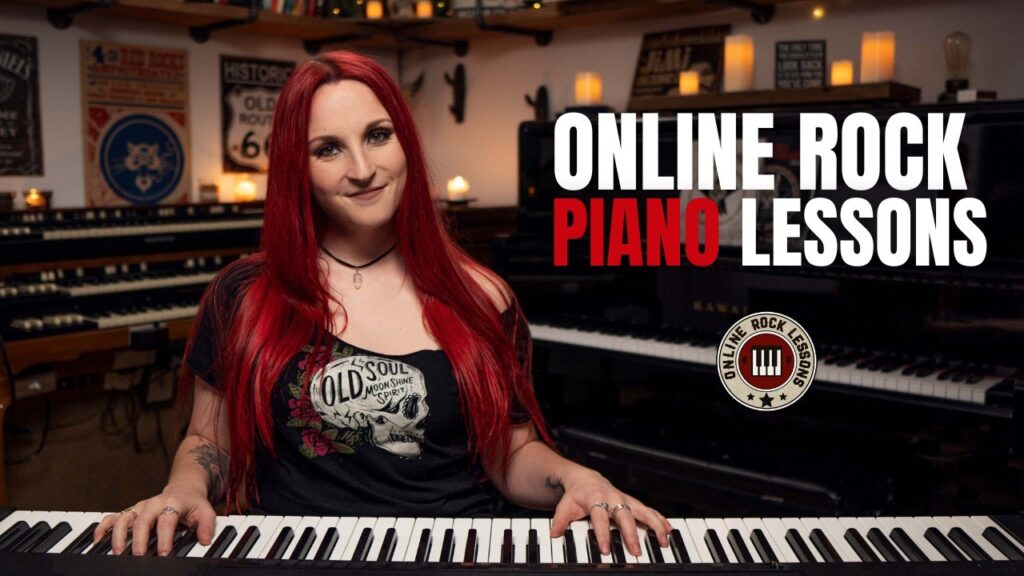
This is a fantastic option if you are mostly interested in rock music (and if you’re interested in Hammond organ!) This course was created and is taught by Marine Lacoste, who is not only a fantastic instructor & pianist, but she is also a very accomplished hammond organ player – she performs regularly with her own band, as well as playing keys regularly for multiple recording artists on tour. I started this course in 2023 when I joined a band, and it is helping me greatly in taking my playing to a new level!
If you sign up for Online Rock Lessons yearly subscription, use code PIANOTONE at checkout to let Marine know I referred you, and she will give you a free 20 minute orientation call!
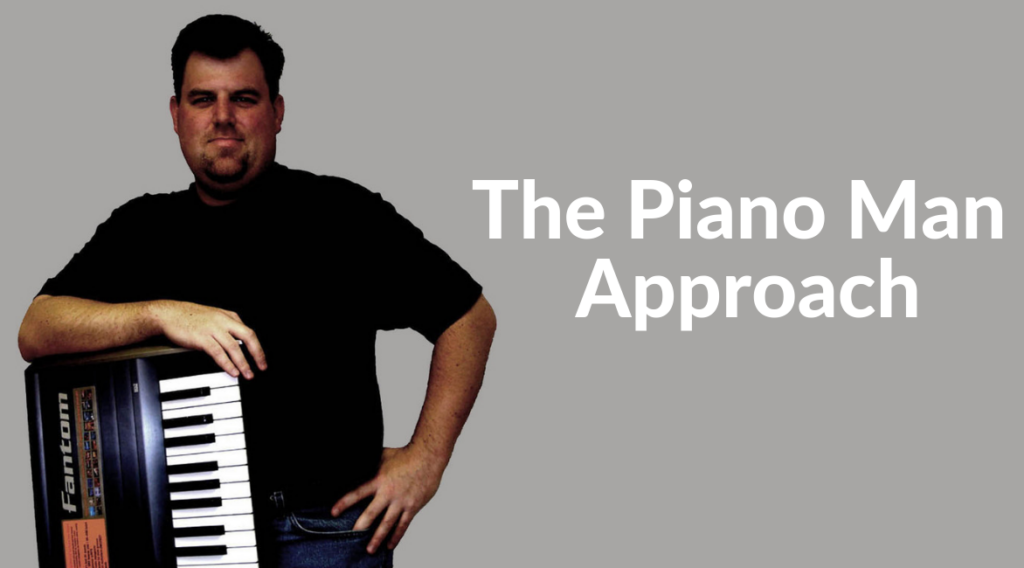
This course is an amazing option for learning piano from beginner up to being able to perform; it teaches multiple genres of music and focuses on how to be a “one person band” on the piano. This course is taught by pro pianist Steve Lungrin – Steve has been teaching and performing his whole adult life and is a fantastic instructor and performer.
I took this course from 2020 to 2021 and it elevated my playing from a very basic level to being able to play songs in multiple genres.
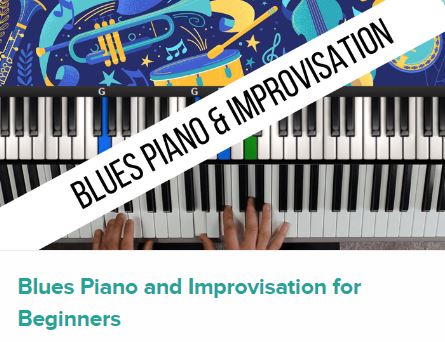
Bird’s Piano Academy (Beginner Blues):
If you like the blues, and (or) want to ramp up your improv/soloing abilities on the piano, this is a GREAT course. It’s taught by Arthur Bird, who has a number of courses available on blues, jazz, as well as just getting started on piano. I found his beginner blues & improv course in 2022 when I “hit a wall” in my soloing abilities, and it really helped my improv and soloing in a big way.

If you’re looking for the least expensive way to get started on piano, Pianoforall is a great option. It’s a unique course created by Robin Hall that uses downloadable eBooks with embedded videos and audio instead of a website.
